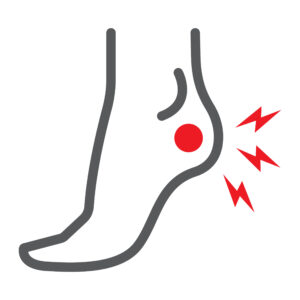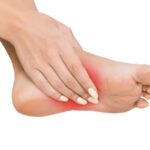
09 Oct How to Fix Plantar Fasciitis: Why Your Foot Hurts & What to Do About It
What is plantar fasciitis? Why is it more common certain times of the year? Why does it affect you (and not your friend)? Let’s tackle some common questions about this pesky issue – and what to do if you’re dealing with it!
What is plantar fasciitis?
Your plantar fascia is a thick band of tissue that runs from your heel to the bottom of your toes. When it becomes irritated and inflamed, that is plantar fasciitis. PF can be mild or severe and can be acute (coming on suddenly) or chronic (lasting months or longer).
What are the symptoms of plantar fasciitis?
You may experience:
💥Heel pain
💥Pain first thing in the morning
💥Pain after sitting for long periods
💥Pain in the arch of your foot
What are risk factors for PF?
You might have a higher risk for plantar fasciitis if:
![]() You have high arches
You have high arches
![]() You have flat feet
You have flat feet
![]() You have tight calves
You have tight calves
![]() Your ankles have limited mobility
Your ankles have limited mobility
![]() You wear ill-fitting or non-supportive shoes
You wear ill-fitting or non-supportive shoes
![]() You wear high heels
You wear high heels
![]() You are on your feet a lot
You are on your feet a lot
![]() You’ve recently started or increased your physical activity
You’ve recently started or increased your physical activity
![]() Your exercise is repetitive: dancing, running, jumping, etc.
Your exercise is repetitive: dancing, running, jumping, etc.
How to Treat PF
How to improve your symptoms:
![]() Roll your arches over a frozen water bottle
Roll your arches over a frozen water bottle
![]() Rest – take time off your activities/exercise
Rest – take time off your activities/exercise
![]() Stretch your calves
Stretch your calves
![]() Stretch your foot by gently pulling your toes up
Stretch your foot by gently pulling your toes up
![]() Invest in some supportive shoes
Invest in some supportive shoes
![]() See a physical therapist
See a physical therapist
Sometimes, plantar fasciitis responds to conservative, at-home treatment, but if you’re not finding relief it’s time to see a physical therapist. Plantar fasciitis is one of the most common issues people seek help for, especially because it can become chronic and can limit both your daily activities and exercise. Physical therapy has a high success rate for improving PF symptoms, and utilizes a variety of treatment methods, like: manual (hands-on) therapy, IASTM (instrument-assisted soft tissue mobilization) like Graston Technique, and dry needling.
You’ll work with a physical therapist to identify potential factors that contribute to your PF, as well as any areas of tightness or weakness that may affect your condition. You’ll receive a custom treatment plan which is typically a blend of in-clinic visits and home exercise. Your PT will guide you on how you can slowly increase your activity or return-to-sport to minimize any discomfort.
At Body One, our PTs and PTAs work one-on-one with patients in a supportive, comfortable environment. We offer private treatment rooms and the consistency of seeing the same one or two providers throughout your course of treatment. We know how painful and frustrating plantar fasciitis can be, and we’re ready to help get you back on your feet – literally. We have three convenient locations in North Indy: Fishers, North Meridian, and Zionsville. Schedule today!





